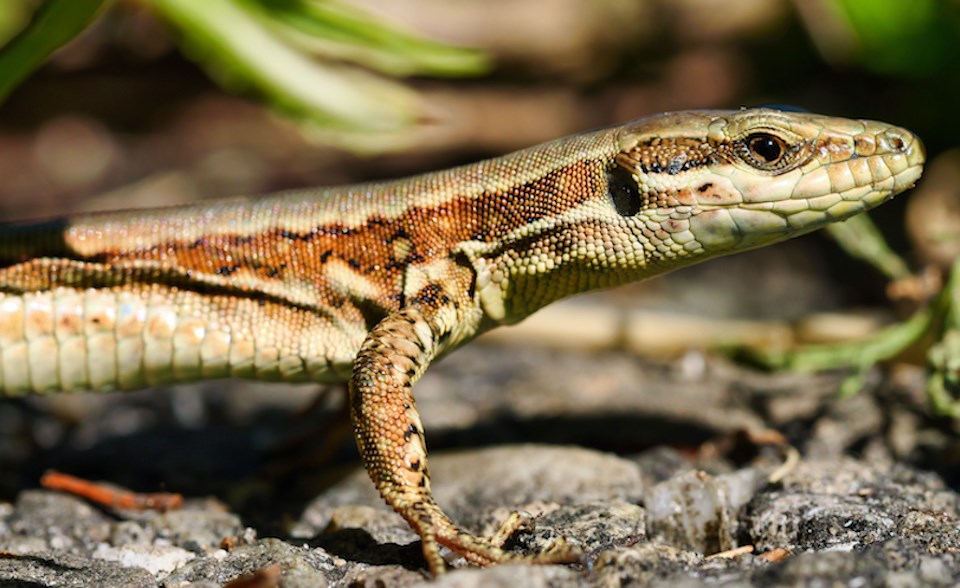They have the word "common" in their name -- but they aren't supposed to be commonly spotted in British Columbia.
Not unlike several other invasive species, the common wall lizard (Podarcis muralis) took up residence in B.C. by virtue of some irresponsible human behaviour.
A group of the slender-bodied lizards was released from a zoo in West Saanich on Vancouver Island in the 1960s and the rest is invasive animal history -- mostly.
Since their initial release in the wilds of B.C., the common wall lizard has started living up to its name, appearing more frequently in the habitats of native species, such as the northern alligator lizard, at a concerning pace.
Researcher Leigh Anne Isaac says the small lizards were brought in for entertainment and education but continue to spread across the province, including Metro Vancouver.
Without the help of humans, common wall lizards spread at a rate of roughly 100 metres per year, which isn't that fast. But they are thought to be spreading much quicker by hitchhiking on cars, shipments of produce, or plants, and by people who released them after owning them as pets, according to the Invasive Species Council of BC.
"We don't know as much about the impact [of them] and are working to understand what it is," Isaac tells V.I.A., noting that they are in "indirect competition" with other animals because they consume food that native species eat and also compete for living space.
But they may pose an even greater risk if they eat threatened wildlife, including pollinators or endangered lizards or snakes.
Common Wall Lizards threaten native species
As B.C.'s Small Mammal and Herpetofauna Specialist, Issac sees first-hand the damage an invasive critter can cause in a local ecosystem. While some animals have a more modest impact, others, such as the American bullfrog, can indirectly assist in the extinction of other species.
Bullfrogs carry a fungus on their skin that causes Chytridiomycosis in amphibians. This infectious disease has led to staggering population declines of hundreds of species around the world, as well as the extinction of at least 90.
While common wall lizards don't carry any bacterium or diseases, they still threaten local populations because they are considered "successful invaders due to their diet, reproduction and temperature tolerance."
Not only do they feed on a range of small invertebrates, but they will also feast on fruit and berries. Depending on the length of summer, they lay three to 11 eggs once or twice a year.
To avoid the winter deep freeze, they hibernate below the frost for several months.
In addition to other lizards, the common wall lizard also competes for food and living space with B.C.'s endangered Sharp-tailed Snake, which is found on Vancouver Island.
How to tell a common wall lizard apart from lizards that are native to B.C.
The common wall lizard has a "long, slender, flattened body with long fingers and toes" and can grow up to 6.3 cm in length from its petite snout to the base of its tail. Their tails can be quite long (up to 1.5 times the length of their bodies).
They vary in colour, ranging from brown to grey to green, and don't have skin folds on the back and sides of their bodies. However, they may have black-blue spots on their flanks, particularly if they are males, and they may have "prominent flecks of green on the back, which may be more intense near the shoulders," according to the B.C.'s Invasive Species Guide.
Common wall lizards are often confused with B.C.'s native northern alligator lizards but the latter has skin folds on its sides with "bead-like scales" and "large platelike scales" on its back.
Despite being a couple of centimetres larger, the alligator lizard has short fingers and toes, compared to the long ones of the common wall lizard. They also aren't as fast and tend to hide under cover.
Northern alligator lizards are not quite as fast as common wall lizards and are often found under cover. Northern alligator lizards may be coppery brown to grey, but overall have a "drabber" colour than their invasive look-a-likes.
Another invasive species, the Italian wall lizard, may also be confused with the common one. However, these lizards do not have "any dark spots on their throat or belly" that the common species do.
What you can do to prevent the spread of the common wall lizard in B.C.
Common wall lizards are found across Europe and the ones found in B.C. are thought to be native to Italy. This theory garners significant confusion because the other invasive lizard in B.C. is the Italian wall lizard.
The Government of B.C. encourages the public to learn how to identify the species and raise awareness about its spread in the province, noting that some "escaped or intentionally released pets may have also established additional populations."
You should not import, sell, or keep any of the common wall lizards as pets. If you are transporting materials, check for reptilian stowaways in boxes.
If you plan on catching one of the wily critters by its tail, you probably won't be able to keep it for very long -- and you shouldn't attempt to handle them, anyway (wildlife are unpredictable and can attack you or you can hurt them).
Not unlike many other lizard species, these invasives can drop their tails when desperate times call for tail-less measures. To distract the predator, their newly autonomous tail will even wiggle for a few minutes after they detach it.
A new tail quickly generates in place of the old one, although the new one typically shows a "different colour and scale pattern, is shorter than the original, and can be bent to one side," describes B.C.'s Invasive Species Guide.



